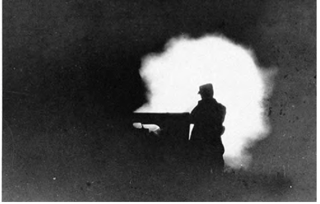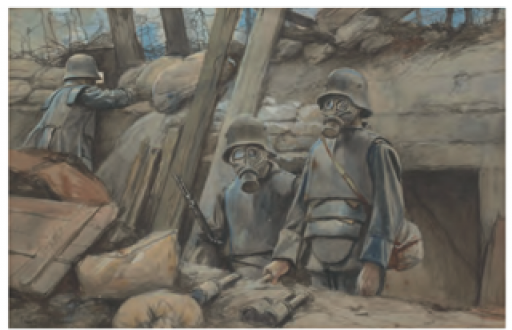A exhibition looking at how the First World War was portrayed in paintings, photos and print by those who went to the Front, can be seen at Les Invalides in Paris, the home of France’s national Army Museum.
The millions of soldiers who left to fight in 1914, encouraged by imaginery scenes of heroic patriotism produced before the war, were confronted with a very different reality on the battlefield.
The Centenary exhibition, Vu du Front – Représenter la Grande Guerre, aims to show the shifts in attitude captured by those who depicted the scenes around them, from the optimism of 1914 to the ‘profoundly changed’ societies of 1918.
Paintings, drawings, private and official photographs, newspaper articles, films, posters are among 500 items on show, some of them for the first time.

Louis Danton: Night firing at the Battle of the Marne,Tracy-le-Mont, September 6th 1914 (Modern print from an original negative, courtesy Army Museum, Paris)
Many of the best known war artists and writers are represented at Vu du Front: Otto Dix, William Orpen, Paul & John Nash, Guillaume Apollinaire, Jacques Villon, Fernand Léger, Felix Vallotton, Edouard Vuillard and Georges Scott.
The belligerent powers, keen to counter the scenes emerging from the trenches, sent artists and photographers on official commissions to the Front.
Mass warfare resulted in unprecedented numbers of personal accounts of the fighting, as soldiers recorded their experiences in sketches, illustrated letters, notebooks and amateur photos.
New weapons and techniques, such as aviation and camouflage, caught the eye of First World War artists. They were explored not only from an aesthetic point of view, but also as illustrations of the new power of war and enemy barbarism
Jean Galtier-Boissière’s 1919 painting of maimed veterans makes clear that artistic expression did not stop with the Armistice. But as the exhibition points out, the Front was still being portrayed decades after the guns fell silent.
‘Vu du Front – Représenter la Grande Guerre’ can be seen at the Army Museum, Hôtel des Invalides, Paris, until January 25th 2015. The exhibition is a co-venture between Le Musée de l’Armée and La Bibliothèque de documentation internationale contemporaine (BDIC). More details can be found here.
Source: Museum of the Army, Paris
Images: François Flameng (1856-1923): Guetteurs allemands équipés de cuirasses de tranchées et de masques à gaz, Août 1917. Crayon et aquarelle, avec rehauts de gouache, sur papier. Paris, Musée de l’Armée.
Louis Danton (1889-1960): Tir de nuit, bataille de la Marne, Tracy-le-Mont, 6th Septembre 1914. Tirage moderne d’après un négatif gélatino-argentique sur nitrate de cellulose. Paris, Musée de l’Armée.
Posted by: Peter Alhadeff, Centenary News
